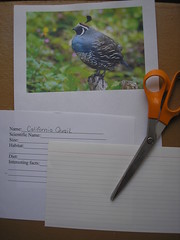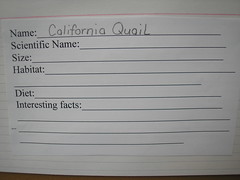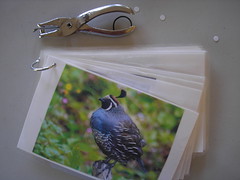“If a child is to keep alive his inborn sense of wonder, he or she needs the companionship of at least one adult who can share it, rediscovering with him the joy, excitement, and mystery of the world we live in.” Rachel CarsonOne nature activity that our family has worked on together is to start and maintain a personalized field guide to birds that frequent our birdfeeder and backyard. We started a few years ago and have added each new kind of bird as we come across it. The instructions are for bird cards but you could easily adapt the idea for trees, wildflowers, insects, flowerless plants, or garden flowers.
How to Make Field Guide Cards
Materials:
5 x 8 index card
Bird photograph
glue stick
Optional: Blank bird information form,lamination, binder ring

1. We take a photo of the bird we want to add to our field guide or if we can’t take a decent photo, we find one on the internet and print it out on our color printer.

2. Glue the photo on one side of the 5 x 8 card.

3. We fill in the blank bird information form with information from our field guide.
4. Glue the information onto the back of the card.

5. Optional: Laminate the card.

6. Optional: We hole punch the corner of each card and attach it to a binder ring.
Here is a copy of the blank information form we use.
PDF of bird field guide blank
Please note: I want to clarify the idea of picking a focus area. The focus area is a topic in the Handbook of Nature Study that your family is choosing to learn about in more depth. Challenge #5 suggested making a list of things you found within your focus area that you might come into contact with in your local area. I suggested that you work in a specific focus area for six to eight weeks so you could really get to know a certain aspect of nature. Each week I am suggesting that you read about one item from your list in the Handbook of Nature Study. This gives you some ideas for observations when you go outside with your children. If on your nature walk you find something else to be interested in, please feel free to go with that interest. I am not trying to limit you but to have some sort of way to direct your nature study. In my experience, as I change our family's focus, we are hyper-sensitive to finding things in that focus area to learn about because we are more aware. It narrows down our vision a little so we can really get to know our own backyards. I hope that clears up any misunderstanding.
Outdoor Hour Challenge #7
Your Own Field Guide
1. In your focus area, turn to the table of contents and pick a new subject in your section to read about before your nature walk. Make sure to read the observation suggestions to have them in mind before your time outdoors. Take your 10-15 minute walk, looking for things to add to your list of focus area items in your nature journal. Spend some of your time quietly observing and try to encourage your child to look closely at something they have seen before to recognize any changes or new aspects of the item. For example, if you are focusing on flowerless plants, see if you can find some differences between flowerless plants and garden plants. [lack of leaves, petals, or roots]
“Children should know the correct name for parts of things, such as petals, sepals, etc, to help them describe what they see. They should be encouraged to group things together by leaf shape, or leaf vein pattern, or number of flower petals, or whether they keep their leaves all year, or animals that have a backbone, or animals that eat grass or eat meat, etc. Collecting and sorting plant specimens is fun and good practice.” Charlotte Mason, volume 1, page 632. After your outdoor time, take time to discuss the outing with your child, helping them to find words to describe their experience. Add anything new to your list of items observed in your focus area that you are keeping in your nature journal. Make note of any additional research that needs to be done for things your child is interested in.
“The ability to group things together by type and find differences is one of the higher orders of intellect, and every opportunity to use it first-hand should be encouraged.” Charlotte Mason, volume 1, page 643. Give an opportunity for a nature journal entry. Remember this can be a simple drawing, a label, and a date. Challenges 2 and 3 have ideas for alternatives to drawing in the nature journal.
4. Add any items to your collection that you discovered during your nature time. If you need more information on making a collection, see Challenge #6. Or if you are choosing to start making a field guide with your children, gather the materials and make your first card.
5. Post an entry on your blog.

You can link up by clicking the carnival button or you can send them directly to me: harmonyfinearts@yahoo.com.
You can purchase all of the first ten challenges in a convenient ebook along with custom notebook pages.


No comments:
Post a Comment